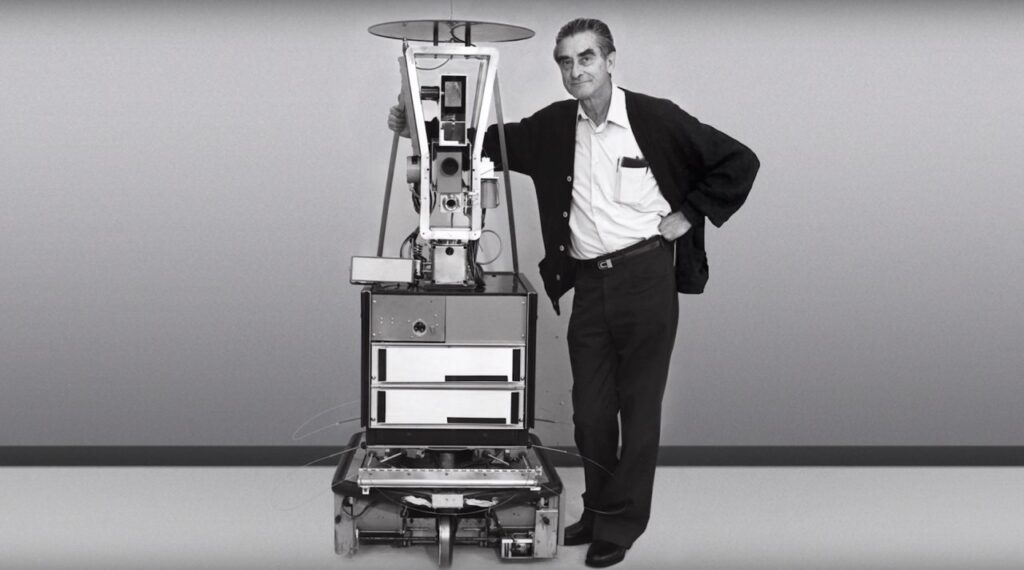Introduction:
Shakey the Robot, an illustrious creation of its time, emerged as a veritable marvel in the annals of robotics and artificial intelligence. Its genesis can be traced back to the hallowed halls of the Stanford Research Institute (now SRI International) in Menlo Park, California, during the late 1960s and early 1970s.
This visionary undertaking not only symbolized a pioneering effort but also laid the very cornerstone upon which countless subsequent advancements in the realms of robotics and AI would be erected. Charles Rosen, head of the AI group at SRI, recalling the origin of the robot’s name: “We worked for a month trying to find a good name for it, ranging from Greek names to whatnot, and then one of us said, ‘Hey, it shakes like hell and moves around, let’s just call it Shakey.
Shakey was historically significant because of three distinct reasons:-
- How its control software was structured- it later became a layer for subsequent robots.
- Its computer vision, planning and navigation methods have been used not only in subsequent robots but also many other appliances.
- Shakey served as an existence proof that encouraged later developers to develop more such robots.
THE HISTORICAL TAPESTRY OF SHAKEY THE ROBOT UNFURLS AS FOLLOWS:
- Embarking on the Quest (1966): The inception of the Shakey project transpired in 1966 under the aegis of the Stanford Artificial Intelligence Project (SAIL), presided over by the esteemed Dr. Charles Rosen. The audacious aim was to craft a robot endowed with the capacity to comprehend its surroundings, deliberate upon its actions, and, most remarkably, traverse an ever-changing environment independently.
- Forging the Mechanical Marvel: The physical manifestation of Shakey materialized atop a four-wheeled chassis, replete with an array of sensory apparatus. Among these sensory faculties were television cameras, a laser rangefinder, and collision-detecting sensors. These technological adjuncts endowed Shakey with a rudimentary form of perception.
- Coding the Intellect: Nevertheless, it was the software underpinning Shakey that truly set it apart. The robot was programmed utilizing the “STRIPS” (Stanford Research Institute Problem Solver) system—an early AI platform designed for planning and problem-solving. This software bestowed upon Shakey the ability to devise plans, resolve intricate quandaries, and carry out tasks within an environment marked by constant flux.
- Inaugural Exhibitions (Late 1960s): Shakey’s initial public appearances showcased its capability to execute elementary chores such as relocating objects, negotiating through doorways, and erecting stacks of blocks. These seemingly mundane tasks necessitated the robot’s capacity to perceive its surroundings, engage in strategic planning, and conduct operations autonomously.
- A Crucible of Innovation: The advent of Shakey catalyzed groundbreaking research across an array of AI and robotics subfields—ranging from computer vision to natural language comprehension and planning. It served as an experimental crucible for a diverse spectrum of AI methodologies.
- Shaping Subsequent Exploration: The profound impact of Shakey extended beyond its immediate accomplishments. It exerted an indelible influence on the trajectory of future robotic and AI research endeavors. It demonstrated, in no uncertain terms, the viability of creating intelligent, mobile automatons capable of interacting with their surroundings, rendering decisions, and navigating complex problem-solving scenarios.
- Legacy of Eminence: While Shakey’s capabilities may appear somewhat modest when juxtaposed against contemporary robotic achievements, its legacy remains indomitable. It inaugurated an era of empirical AI and robotics research, inspiring subsequent generations of innovators to push the boundaries of what autonomous machines could achieve.
Achievements, Awards and Recognition
- The project attracted a lot of media attention after SRI released a 24-minute movie titled “SHAKEY: Experimentation in Robot Learning and Planning” in 1969.
- The New York Times published an article on Shakey on April 10, 1969; Life referred to him as the “first electronic person” in 1970; and National Geographic Magazine wrote an article about Shakey and the future of computers in November 1970.
- Because of the major influence of the 1969 video, the prizes for the Association for the Advancement of Artificial Intelligence’s AI Video Competition are referred to as “Shakeys.”
- Alongside famous robots like ASIMO and C-3PO, Shakey was honored into Carnegie Mellon University’s Robot Hall of Fame in 2004.
- A prestigious IEEE Milestone in Electrical Engineering and Computing has been awarded to Shakey.
- Shakey was also featured in the BBC documentary, Towards Tomorrow
References-
- SRIInternational, The man, the myth, the legend: Meet Shakey the robot, the world’s first AI-based robot, (Nov,2021
- Chris Gracia, Robots are a few of my favourite things, Computer History Museum, (June 17,2015) https://computerhistory.org/blog/robots-are-a-few-of-my-favorite-things-by-chris-garcia/


